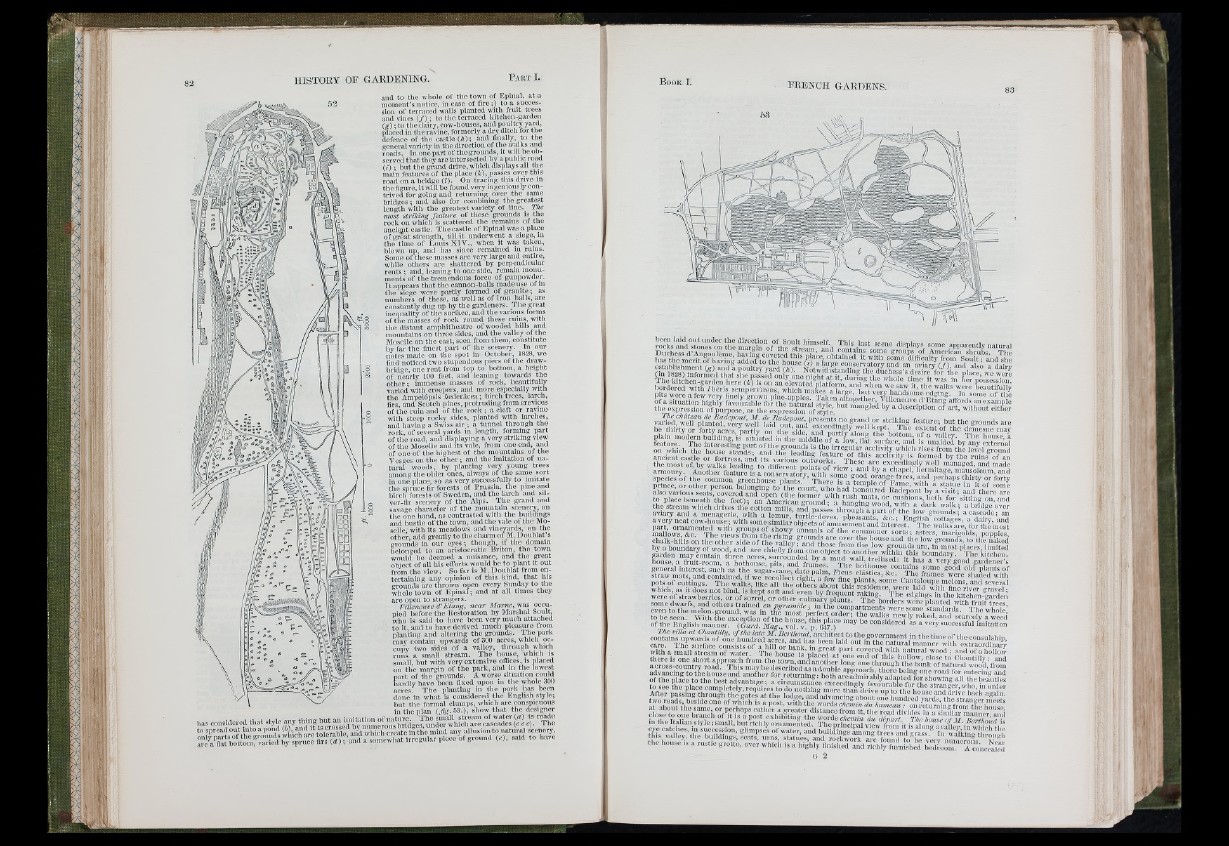
i'l'i
and to th e whole of the town of Epinal, a t a
moment’s notice, in case of fire ;) to a succession
of terraced walls planted with fruit trees
and vines ( / ) ; to the terraced kitchcn-gardcn
( g ) ; to th e dairy, cow-houses, and poultry yard,
placed in the ravine, formerly a dry ditch for the
defence of th e castle (k ) ; and finally, to the
general variety in the direction o fth e walks and
roads. In one part of the grounds, it will be observed
th a t they arc intersected by a public road
(i) ; b u t the grand drive, wliich displays all the
main features of th e place (¡c), passes oyer this
road on a bridge (7). On tracing this drive in
th e figure, it will be found very ingeniously contrived
for going and returning over tho same
bridges ; and also for combining the greatest
icngtii with the greatest variety of line. The
most striking feature of these grounds is the
rock on which is scattered the remains ot the
anciqpt castle. The castle of Epinal was a place
of great strength, till it underwent a siege, m
the time of Louis XIV ., when it was taken,
blown up, and has since remained in ruins.
Some of these masses are very large and entire,
while others are shattered by perpendicular
rents ; and, leaning to one side, remain monuments
of the tremendous force of gunpowder.
It appears that th e cannon-balls made use of in
th e siege were partly formed of g ra n ite ; as
numbers of these, as well as of iron _balls, are
the distant amphitheatre of wooded hills and
mountains on three sides, and th e valley of the
Moselle on the east, seen from them, constitute
by far the finest part of the scenery. In our
notes made on the spot in October, 1828, we
find noticed two stupendous piers o fth e drawbridge,
one rent from top to bottom, a height
of nearly 100 feet, and leaning towards the
other ; immense masses of rock, beautifullv
varied with creepers, and more especially with
th e AmpelÔpsis /¿ederàcea; birch trees, larch,
firs, and Scotch pines, protruding from crevices
of the ruin and of the rock ; a cleft or ravine
with steep rocky sides, planted with larches,
and having a Swiss air ; a tunnel through the
rock, of several yards in length, forming part
of the road, and displaying a very striking view
of the Moselle and its vale, from ono end, and
of ono of th e highest of th e mountains of the
Vosges on th e other ; and th e imitation of n a tu
ral woods, by planting very young trees
among th e older ones, always of th e same sort
in one place, so as very successfully to imitate
th e spruce fir forests of Prussia, the pine and
birch forests of Sweden, and the larch and sil-
vcr-fir scenery of the Alps. The grand and
savage character of the mountain scenery, on
th e ono hand, as contrasted with the buildings
and bustle of the town, and th e vale of the Moselle,
with its meadows and vineyards, on the
other, add greatly to the charm ol M. Doublât s
grounds in our eyes ; though, if th e domain
belonged to an aristocratic Briton, th e town
would be deemed a nuisance, and th e great
object of all his efforts would be to plant it out
from th e view. So far is M. Doublât from entertaining
any opinion of this kind, th at lus
grounds are thrown open every Sunday to the
whole town of Epinal ; and a t all times they
are open to strangers.
Villeneuve d 'Etang, near Marne, was occupied
before th e liestoration by Marshal Soult,
who is said to liave been very m uch attached
to it, and to have derived much pleasure from
planting and altering the grounds. I h e park
mav contain upwards of 300 acres, which occupy
two sides of a valley, through which
runs a small stream. T h e house, w h ift is
small, but with very extensive offices, is placed
on the margin of th e park, and in th e lowest
p a rt of th e grounds. A worse situation could
hardly have been fixed upon in the whole 300
acres. The planting in th e park has been
done in what is considered the English style;
but th e formal clumps, which are conspicuous
in th e plan (fig . 53.), show that the designer
to spread out into a pond ( 6 ), and it is c r o s s w n y im u c h allusion to natural scenery,
• st 1 description of art, without citlic
m a m m
were of strawberries, or of sorrel or other eniimVu om j edgings in the kitchen-garden
s . ï Æ i d s K r S . ?
H
's
1 ■